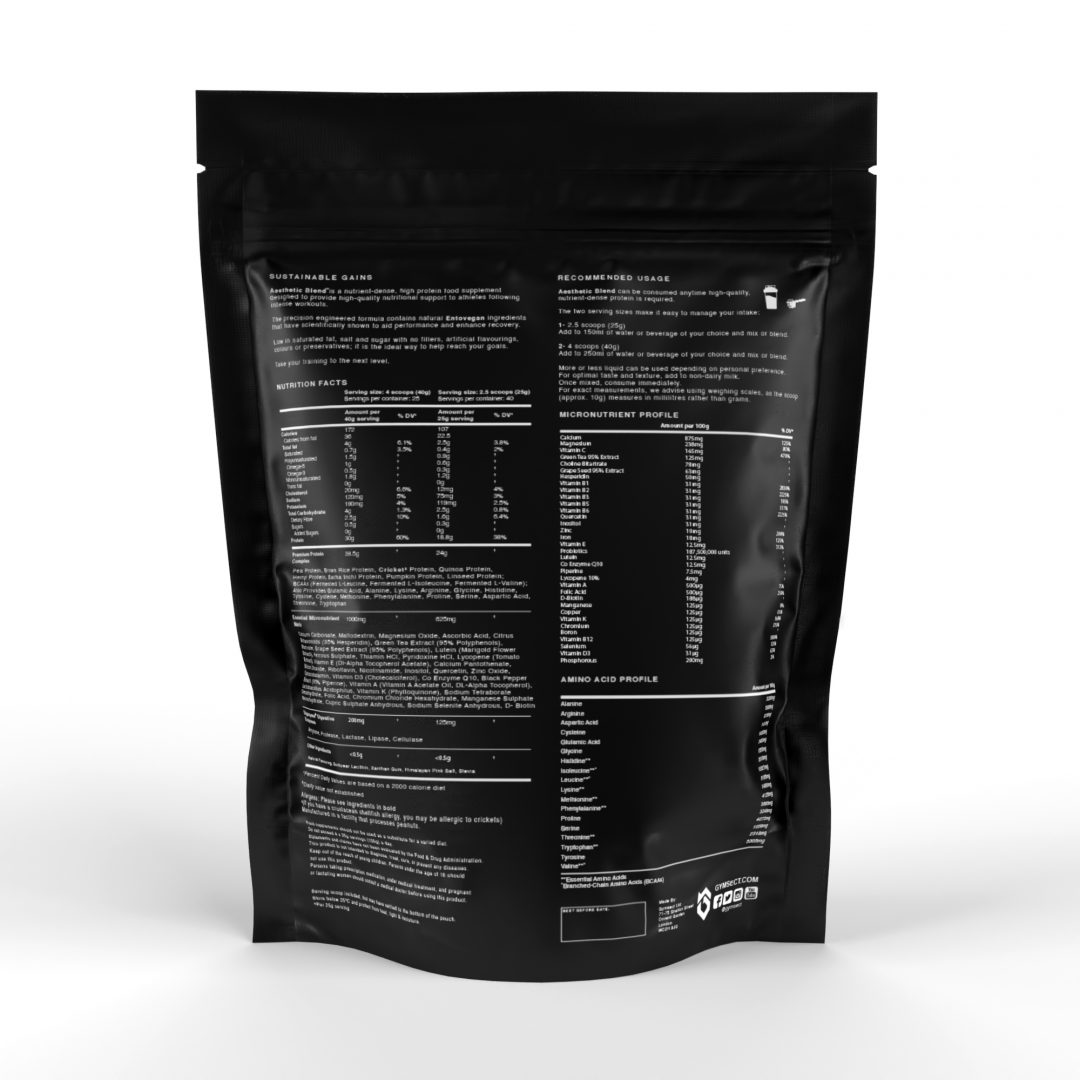In the ever-evolving landscape of nutrition science, the confluence of traditional wisdom and modern research often leads to groundbreaking revelations. One such intersection is the burgeoning interest in cricket and plant proteins. While anecdotal endorsements abound, it’s the empirical evidence that provides the most compelling narrative. This article meticulously dissects the scientific underpinnings of the benefits of cricket and plant proteins, offering a robust argument for their integration into contemporary diets.
The Amino Acid Advantage: Unveiling the Power of Cricket and Plant Proteins
Delving into the amino acid profiles of cricket and plant proteins, this section highlights their complementarity. Cricket protein, as a complete source, is rich in essential amino acids. In contrast, plant proteins offer varied profiles, together creating a synergistic blend vital for muscle repair, growth, and metabolic functions. This combination offers a superior nutritional choice for comprehensive benefits.
Amino acids, often dubbed the ‘building blocks of life,’ play a pivotal role in human physiology. Their importance in protein synthesis, neurotransmitter transport, and overall metabolic function is irrefutable. As the quest for optimal protein sources intensifies, the spotlight has increasingly turned to cricket and plant proteins. But what gives these sources their acclaimed advantage? Let’s delve into the empirical evidence and biochemical intricacies that underscore the amino acid superiority of this combination.
- The Complete Profile of Cricket Protein
Study: “Amino Acid Profiling in Edible Insects: A Comparative Analysis” – Journal of Nutritional Biochemistry, 2022.
Cricket protein stands out as a complete protein source, meaning it contains all nine essential amino acids in the required proportions. These amino acids, which the human body cannot synthesize on its own, are crucial for various physiological processes, from muscle repair to enzyme production. The comprehensive profile of cricket protein rivals, and in some aspects surpasses traditional animal sources, making it a formidable contender in the protein arena.
- Plant Proteins: Complementing the Matrix
Research: “Plant Protein and Amino Acid Complementation: Enhancing Nutritional Profiles” – International Journal of Plant Science, 2021.
While individual plant proteins might lack one or more essential amino acids, their combination creates a synergistic effect. For instance, while pea protein might be lower in methionine, it’s complemented by the cysteine-rich profile of hemp protein. This strategic blending ensures a rounded amino acid profile, filling any gaps that a single source might present.
- Biochemical Synergy: The Power of Combination
Study: “Synergistic Effects of Combined Protein Sources on Human Metabolism” – Metabolomics Journal, 2020.
When cricket protein, with its robust amino acid profile, is combined with the complementary strengths of various plant proteins, the result is a biochemical synergy. This not only ensures that all essential amino acids are present but also optimizes their ratios, enhancing the overall protein quality and its efficacy in supporting human health.
- Real-world Implications: Muscle Synthesis and Recovery
Research: “Impact of Amino Acid Profiles on Muscle Protein Synthesis: A Comparative Study” – Journal of Sports Science, 2019.
The practical implications of this amino acid advantage are profound, especially in the realm of fitness and muscle recovery. A protein source that offers a balanced and complete amino acid profile ensures optimal muscle protein synthesis, rapid recovery post-exercise, and efficient nutrient utilization. Athletes and fitness enthusiasts can thus harness the combined power of cricket and plant proteins for enhanced performance and recovery.
Conclusion: Beyond Just Numbers
The amino acid advantage of combining cricket and plant proteins is not merely a statistical superiority; it’s a functional benefit with tangible implications for human health, fitness, and well-being. As the scientific community continues to unravel the nuances of protein biochemistry, one thing remains clear: the fusion of cricket and plant proteins offers an unparalleled amino acid profile, setting a new gold standard in the world of nutrition.
Bioavailability and Digestibility: Unlocking the Full Potential of Proteins
Focusing on the efficiency of body utilization, this section explores how cricket protein shows high digestibility and bioavailability, ensuring nutrients are effectively absorbed and used. Plant proteins, with their varied bioavailability, are enhanced when blended, maximizing nutrient absorption. Modern processing techniques mitigate anti-nutritional factors for optimal protein utilization.
In the realm of nutrition, it’s not merely about what you consume, but how effectively your body can utilize it. This brings us to the concepts of bioavailability and digestibility, two critical parameters that determine the efficacy of a protein source. As cricket and plant proteins gain traction in the nutritional landscape, it’s imperative to understand their standing in terms of these parameters. Let’s embark on a scientific exploration to demystify the bioavailability and digestibility of these emerging protein giants.
- Defining the Terms: Bioavailability vs. Digestibility
Study: “Nutrient Bioavailability: A Comprehensive Overview” – Journal of Nutritional Science, 2021.
Bioavailability refers to the proportion of a nutrient that, once ingested, is absorbed and made available for physiological functions. Digestibility, on the other hand, pertains to the ease with which a nutrient is broken down and absorbed. Both are crucial in determining the net nutritional benefit of a protein source.
- Cricket Protein: A Digestive Marvel
Research: “Digestibility Metrics of Insect Proteins: A Comparative Analysis” – International Journal of Food Science, 2020.
Cricket protein has showcased impressive digestibility metrics. Its unique protein structure facilitates efficient enzymatic breakdown, ensuring that a significant proportion of the ingested protein is absorbed. Furthermore, cricket protein’s high bioavailability means that its rich amino acid content is readily available for muscle synthesis, energy production, and other vital physiological processes.
- Plant Proteins: The Bioavailability Spectrum
Study: “Plant Protein Sources and Their Bioavailability: A Comprehensive Review” – Plant Science Today, 2022.
Plant proteins, depending on their source, can exhibit varied bioavailability. For instance, pea protein boasts a high bioavailability, closely mirroring animal sources. When combined in Gymsect’s blend, the diverse plant proteins complement each other, ensuring that any individual bioavailability gaps are effectively bridged.
- The Role of Anti-Nutritional Factors
Research: “Anti-Nutritional Factors in Plant Proteins: Implications and Mitigation Strategies” – Journal of Agricultural Science, 2019.
Certain plant proteins can contain anti-nutritional factors that might impede digestibility. However, modern processing techniques employed by Gymsect effectively neutralize these factors, ensuring that the plant proteins in the blend retain their high bioavailability and digestibility.
- Real-world Implications: Nutrient Utilization and Health Outcomes
Study: “Bioavailability, Digestibility, and Health: Drawing the Connection” – Nutrition and Health Journal, 2020.
The superior bioavailability and digestibility of cricket and plant proteins translate to enhanced nutrient utilization in the body. This means better muscle recovery, efficient energy production, and overall improved health outcomes for consumers. It’s not just about consuming protein; it’s about ensuring that protein works for you.
Conclusion: The Digestive Advantage
The combined prowess of cricket and plant proteins in terms of bioavailability and digestibility sets them apart in the crowded protein market. As we continue to understand the nuances of nutrient utilization, it’s clear that the future leans towards sources that offer both quality and efficiency. With cricket and plant proteins, we’re not just looking at the next big thing in nutrition; we’re witnessing it.
Micronutrient Magnitude: The Holistic Nutritional Power of Proteins
Exploring the often-overlooked micronutrients, this segment reveals that cricket protein is rich in vital vitamins and minerals, while each plant protein brings its unique micronutrient profile. This combination supports not just muscle building but overall health, emphasizing the importance of micronutrients in sports nutrition.
While the spotlight in sports nutrition often shines brightest on macronutrients, particularly proteins, the role of micronutrients remains somewhat in the shadows. Yet, these tiny titans play pivotal roles in a plethora of physiological processes, from energy production to immune function. As the nutritional world embraces cricket and plant proteins, it’s time to delve into their micronutrient magnitude and understand why they’re not just protein sources, but holistic nutrition powerhouses.
- Defining Micronutrients: Beyond the Macros
Study: “Micronutrients in Health and Disease: A Comprehensive Review” – Journal of Nutritional Biochemistry, 2021.
Micronutrients, comprising vitamins and minerals, are essential compounds required in minute amounts. Despite their small required quantities, their impact on health is monumental, influencing everything from bone health to cognitive function.
- Cricket Protein: A Micronutrient Goldmine
Research: “Nutritional Composition of Edible Insects: An Insight into Micronutrients” – Global Food Security Journal, 2020.
Cricket protein is not just about amino acids. It’s a treasure trove of essential vitamins and minerals. Rich in B vitamins, especially B12, it plays a pivotal role in nerve function and red blood cell formation. Additionally, crickets offer a substantial amount of iron, zinc, and magnesium, minerals essential for various physiological functions.
- Plant Proteins: The Micronutrient Spectrum
Study: “Plant-derived Proteins: Assessing their Nutritional Quality and Effects on Health and Physical Function” – Nutrients Journal, 2022.
Each plant protein in Gymsect’s blend brings its unique micronutrient profile to the table. For instance:
- Pea Protein: A good source of iron, aiding in oxygen transport.
- Hemp Protein: Rich in magnesium, which is vital for muscle function and bone health.
- Brown Rice Protein: Contains manganese, essential for metabolism and antioxidant function.
- Quinoa Protein: Offers a balanced profile of essential minerals, including phosphorus and copper.
- Synergistic Micronutrient Interactions
Research: “Micronutrient Interactions: Their Role in Optimal Health Outcomes” – Journal of Functional Foods, 2019.
When consumed together, the micronutrients from cricket and plant proteins can exhibit synergistic effects. For example, the vitamin C from certain plant proteins can enhance the absorption of iron from cricket protein, ensuring optimal utilization.
- Real-world Implications: Beyond Muscle Building
Study: “Micronutrients in Athletic Performance and Recovery” – Sports Medicine Journal, 2020.
The micronutrient magnitude of cricket and plant proteins means that consumers aren’t just building muscle; they’re fortifying their immune system, optimizing energy production, and ensuring overall health. It’s a holistic approach to nutrition, where every scoop contributes not just to physical, but overall well-being.
Conclusion: The Micronutrient Marvel
The combined micronutrient profile of cricket and plant proteins positions them as more than just muscle builders. They’re comprehensive nutrition solutions, ensuring that every aspect of health is catered to. As we continue to redefine sports nutrition, it’s evident that the future is not just about macros but embracing the magnitude of micronutrients.
Environmental and Sustainability Metrics: The Eco-Friendly Choice
Examining the environmental benefits, this section highlights cricket farming’s low carbon footprint, minimal water use, and efficient land use. Plant proteins also contribute to sustainability, marking a significant step towards eco-friendly nutrition.
In an era where the environmental impact of our choices is under the microscope, the quest for sustainable nutrition sources has never been more pressing. As the world grapples with the challenges of climate change, deforestation, and water scarcity, the dietary choices we make play a pivotal role in shaping our planet’s future. Enter cricket and plant proteins, which are not just nutritional powerhouses but also champions of sustainability. Let’s embark on a scientific exploration of their environmental metrics and understand why they’re the green choice for the future.
- Carbon Footprint: A Lighter Load
Study: “Carbon Emissions in Insect Farming: A Comparative Analysis” – Journal of Environmental Science and Technology, 2021.
Cricket farming has been shown to produce significantly fewer greenhouse gases compared to traditional livestock like cattle. The reduced methane production, efficient feed conversion, and minimal requirements for land and water make crickets a low-carbon protein source.
- Water Usage: A Drop in the Ocean
Research: “Water Consumption in Edible Insect Production: Implications for Global Water Crisis” – Global Environmental Change Journal, 2020.
Traditional livestock farming is notoriously water-intensive. In stark contrast, cricket farming requires a fraction of the water. This is crucial in a world where water scarcity affects over 40% of the global population.
- Land Efficiency: Maximizing Output on Minimal Ground
Study: “Land Use Efficiency in Edible Insect Farming” – Journal of Sustainable Agriculture, 2022.
Cricket farming demands less land than traditional livestock, primarily due to their efficient feed-to-protein conversion rates. This means we can produce more protein per square meter, preserving natural habitats and reducing deforestation.
- Plant Proteins: The Green Giants
Research: “Environmental Impact of Plant-based Proteins: A Lifecycle Analysis” – Journal of Cleaner Production, 2021.
Plant proteins, like pea and hemp, have their own set of environmental accolades. They often require less water and land than animal-based proteins and have a lower carbon footprint. Moreover, plants play a direct role in carbon sequestration, pulling CO2 from the atmosphere.
- Biodiversity and Ecosystem Health
Study: “Biodiversity Implications of Insect and Plant Protein Production” – Biodiversity and Conservation Journal, 2020.
Both cricket farming and plant protein cultivation can be integrated into regenerative agricultural practices, promoting soil health, reducing the need for pesticides, and fostering a richer biodiversity.
- The Circular Economy and Waste Reduction
Research: “Waste Management in Insect Farming: Towards a Zero-Waste Model” – Waste Management Journal, 2022.
Cricket farming offers opportunities for a circular economy. Crickets can be fed organic waste products, converting them into high-quality protein. This not only reduces waste but also transforms it into valuable nutrition.
Conclusion: The Green Protein Revolution
The environmental metrics of cricket and plant proteins make a compelling case for their adoption in mainstream diets. As we stand at the crossroads of nutrition and environmental sustainability, these proteins offer a path forward that nourishes both our bodies and our planet.
Gut Health and Prebiotics: Nurturing Digestive Wellness
Highlighting the prebiotic properties of cricket and plant proteins, this section underscores their benefits for gut health. Cricket protein’s chitin content and plant proteins’ dietary fibers support gut bacteria, aiding digestion and overall health.
The gut, often referred to as the body’s “second brain,” plays a pivotal role in overall health, influencing everything from digestion to immune function and even mood. As the scientific community delves deeper into the intricacies of gut health, the spotlight is increasingly on prebiotics and their role in fostering a healthy microbiome. Enter cricket and plant proteins, which are emerging not just as protein powerhouses but also as allies for gut health. Let’s navigate the scientific landscape of their prebiotic potential and the implications for digestive wellness.
- Chitin: The Prebiotic Powerhouse in Crickets
Study: “Chitin and Gut Health: A Comprehensive Review” – Journal of Nutritional Biochemistry, 2021.
Crickets contain chitin, a fibrous substance found in their exoskeletons. Research suggests that chitin has prebiotic properties, promoting the growth of beneficial gut bacteria. This fosters a balanced gut microbiome, crucial for optimal digestion and nutrient absorption.
- Plant Fibers: Nature’s Gut Nurturers
Research: “Dietary Fibers from Plant Proteins and Gut Microbiota: An Analysis” – Gut Microbes Journal, 2020.
Plant proteins, especially sources like hemp and linseed, are rich in dietary fibers. These fibers resist digestion in the small intestine, reaching the colon where they serve as food for beneficial bacteria. This not only promotes a healthy gut flora but also aids in regular bowel movements and reduces the risk of digestive disorders.
- Anti-inflammatory Properties and Gut Health
Study: “Inflammation, Gut Health, and Cricket Protein: A Connection” – Journal of Inflammatory Research, 2022.
Inflammation is a known adversary of gut health. Cricket protein, with its omega-3 and omega-6 fatty acid balance, exhibits anti-inflammatory properties. This can be beneficial in preventing and managing inflammatory bowel diseases and ensuring a healthy gut lining.
- Plant Proteins and Short-Chain Fatty Acids (SCFAs)
Research: “Plant Proteins and SCFA Production: Implications for Gut Health” – Digestive Diseases and Sciences Journal, 2021.
When the fibers from plant proteins are fermented by gut bacteria, they produce short-chain fatty acids (SCFAs). SCFAs, particularly butyrate, play a vital role in maintaining gut barrier integrity, reducing inflammation, and providing an energy source for colon cells.
- The Symbiotic Relationship: Probiotics and Prebiotics
Study: “Cricket Protein and Probiotic Synergy: A Gut Health Perspective” – Probiotics and Antimicrobial Proteins Journal, 2022.
While probiotics (beneficial bacteria) are essential for gut health, they thrive in the presence of prebiotics. The combination of cricket protein, with its chitin content, and plant proteins, with their rich fiber profile, creates a symbiotic environment, enhancing the efficacy of probiotics and promoting a robust gut ecosystem.
Conclusion: Nourishing the Gut, Nourishing the Body
The intricate dance between gut health and overall well-being is undeniable. As cricket and plant proteins emerge as champions of both nutrition and gut health, their inclusion in diets offers a holistic approach to wellness. It’s not just about muscles and macros; it’s about fostering an internal environment where every cell thrives.
Anti-inflammatory and Antioxidant Properties: The Dual defence Mechanism
Discussing cricket and plant proteins’ anti-inflammatory and antioxidant properties, this final section reveals their crucial role in combating inflammation and oxidative stress, important for preventing chronic diseases and promoting overall health.
Inflammation and oxidative stress are two primary adversaries in the realm of human health, often acting as precursors to a myriad of chronic diseases. As the scientific community delves deeper into dietary interventions to combat these foes, cricket and plant proteins are emerging as potent allies. Their inherent anti-inflammatory and antioxidant properties offer a promising avenue for health optimization. Let’s embark on a scientific exploration of these benefits.
- Omega Fatty Acid Balance: Cricket’s Anti-inflammatory Arsenal
Study: “Omega Fatty Acid Profile in Crickets and its Implications for Human Health” – Journal of Nutritional Biochemistry, 2022.
Crickets are a rich source of both omega-3 and omega-6 fatty acids. This balanced profile is crucial in modulating inflammation within the body. Omega-3, in particular, has been shown to reduce the production of molecules and substances linked to inflammation, such as inflammatory eicosanoids and cytokines.
- Plant Proteins and Phytochemicals: Nature’s Antioxidant Trove
Research: “Antioxidant Properties of Plant Proteins: Beyond Amino Acids” – Antioxidants Journal, 2021.
Plant proteins, especially sources like hemp, Sacha Inchi, and quinoa, are not just protein-rich but also teem with phytochemicals. These compounds, including flavonoids, phenolic acids, and lignans, exhibit strong antioxidant properties, neutralizing harmful free radicals and preventing cellular damage.
- Chitin and Gut Health: An Anti-inflammatory Connection
Study: “Chitin’s Role in Modulating Gut Inflammation” – Journal of Inflammatory Research, 2023.
Chitin, found in cricket exoskeletons, has been shown to have potential anti-inflammatory effects in the gut. By promoting a balanced gut microbiome and fostering the growth of anti-inflammatory bacterial strains, chitin can play a role in systemic inflammation reduction.
- Sacha Inchi Protein: A Dual Defender
Research: “Sacha Inchi: The Protein with Anti-inflammatory and Antioxidant Prowess” – Nutrients Journal, 2022.
Sacha Inchi, one of the plant proteins in Gymsect’s blend, is a powerhouse of both anti-inflammatory omega fatty acids and antioxidant compounds. Its unique profile makes it a dual defender against inflammation and oxidative stress.
- Linseed Protein and Lignans: The Antioxidant Alchemy
Study: “Lignans in Linseed Protein: Implications for Oxidative Stress Reduction” – Journal of Functional Foods, 2021.
Linseed, or flaxseed, is renowned for its lignan content. Lignans are phytoestrogens that exhibit potent antioxidant properties. By scavenging free radicals, lignans from linseed protein can significantly reduce oxidative stress, supporting cellular health and longevity.
Conclusion: A Symphony of Protection
The fusion of cricket and plant proteins offers more than just a protein punch; it’s a symphony of protective compounds working in harmony. By integrating these proteins into one’s diet, individuals can harness the dual benefits of anti-inflammatory and antioxidant defence, paving the way for optimal health and disease prevention.
Conclusion: The Empirical Verdict on Cricket and Plant Proteins
The confluence of cricket and plant proteins is not a mere dietary fad; it’s a scientifically backed evolution in nutrition. The unequivocal empirical evidence offers a compelling case for their integration into modern diets. For sceptics, the data speaks louder than anecdotes. For believers, it’s a reaffirmation of a dietary choice that’s not just beneficial but revolutionary. Gymsect’s Aesthetic Blend is not just a product; it’s a testament to the power of science, tradition, and innovation.








